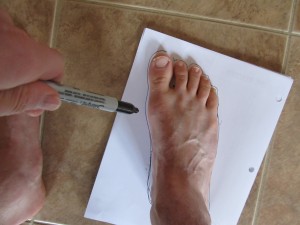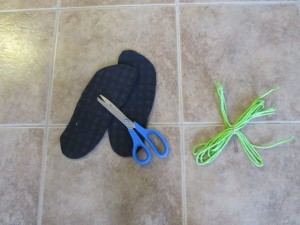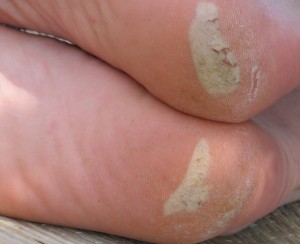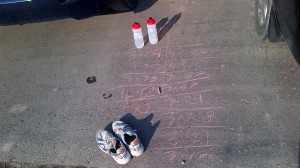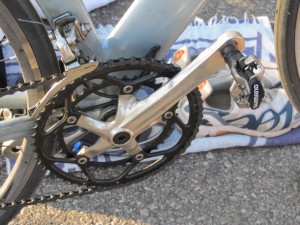One reason I love running so much is that even something as simple as a community 5k can contain all sorts of drama, tension and excitement.
I’m in my off-season at the moment, patiently putting in the miles to prepare for next years ultra-marathon goals, which means that most of my runs are of the ‘long-and-slow’ variety. However, once in a while it’s nice to shake things up a bit, and this morning provided the perfect opportunity.
My plan was to run from home to downtown Barrie, a distance of about 9 or 10 km, in time to run the annual Santa Shuffle. I’d do the race, and then run home. A 25k total would complete this week’s distance goals.
The last few days have had very unpleasant weather; the temperature has hovered around zero and a mix of snow and rain has left a slushy surface on the sidewalks that’s nearly impossible to run on. Fortunately, this morning was bright and sunny and the paths were mostly clear. I loaded up my hip sack with water and snickers bars and started off downtown, an hour before the race was due to start.
I took the run downtown very gently, taking the opportunity to fuel up as I went. I even managed to resist my usual urge of racing any other joggers that I encounter. Down at Heritage park was big crowd, significantly larger than last year. Mayor Jeff Lehman, who somehow manages to attend every community function in the city, gave some brief words of welcome and congratulated us on our healthy example and the thousands of dollars that had been raised for the Salvation Army through entrance fees and donations.
The one-kilometre run went off first, which meant hanging around rapidly losing body heat. I’d planned to arrive just minutes before the race, but that didn’t work out so well. But I’d had the forethought to bring a space blanket, which did a surprisingly good job.
Then the 5k race start was announced and I had my usual panic to find a place to dump my water bottle, take off my jacket and fight through the crowd to the front line. I made it with a few seconds to spare, remembered to reset my stopwatch, and then, “3-2-1 GO,” we were off.
I always feel bad just before a race, nerves and power gels combine to make my legs feel shaky and unsure of my ability to actually turn on the speed when needed. So this time I simply yelled ‘charge’ and sprinted the first hundred metres from the start line. Immediately I was off the front of the pack, but as soon as I settled in to my pace a couple of other runners were right with me. A few more hundred yards and they were already pulling away from me. I let them go; my plan was to not kill myself in the first half of the race. I’ve gone out too hard twice already this season, and this was just meant to be an extended training run anyway.
After the first kilometre, the shape of the race was already becoming clear. Number One, clearly a serious runner by the fact that he was wearing shorts on a snowy day, was pulling steadily away from us. Number Two, wearing a green shirt with a ‘Cross-Country’ slogan on it had already been dropped by him. Although he was a hundred metres ahead of me, he looked like he might already be flagging. If I kept to my plan, maybe I’d haul him in.
There’s a slight hill at the halfway mark, which I went up carefully, trying not to blow up. By the time I got to the top, Number Four had come up from behind and joined me. We stayed neck and neck for a while on the way back, and even chatted a little. Like me, he also does triathlon, and like me is planning on racing Ironman Muskoka next summer. He also cheekily claimed that if he stayed with me to the end he’d beat me in a sprint finish!
Now it was time to get serious, I only had two kilometres left to catch up with Number 2. I switched up from ‘hard training’ pace to ‘serious racing’ pace, and started eating up the distance. But Number Four stayed right on my heels the whole time. When I finally got to a few paces behind Number Two, I decided that a short sprint might be enough to catch and drop him.
Not quite. I ‘burned a match’, and caught up to his shoulder, but that was all. He responded immediately and pulled forward a few paces.
Ok, plan B. Stay loose, focus on style and turnover, breath easily, let your body do what it’s trained for.
That actually worked – as soon as I relaxed I found myself drawing next to Number Two, and we were heading into the final turn. Number Four seemed to have finally been shaken, so the silver medal was in reach.
I love it when I get to the end of a race and still have a sprint finish in me. One of my heroes is Simon Whitfield, who seems to always be able to pull out a devastating sprint went it really matters. And it’s gutting to get to the last stretch with nothing left, and watch helplessly as runners go past you as your body refuses to respond.
Timing is also important. Too soon and too late can both wreck a carefully planned race. Today I got it perfect. In the final hundred metres I kicked into fifth gear, and got the jump on Number Two. Even that wasn’t enough though, as he also had a fifth gear apparently, and was right back on my heels at fifty metres.
Today was my day, though, and for once I had a sixth gear right when I needed it. Maybe it was the aerodynamic ‘Angry Bird’ hat that my talented wife had made for me to wear. But my legs responded perfectly when I asked, and I crossed the line with a personal best on this course of 18:51.
To a serious racer that would just be a gentle training pace, no doubt. But for me it was a chance to show that I can come back from injury and frustration, and with careful planning and training I can get my body to reach the goals I set for it.
So, then I collected my medal, shook hands with the guys that had spurred me on and made it such a fun race, and enjoyed the complimentary hot chocolate from the race organisers.
And then I turned round and ran home.
